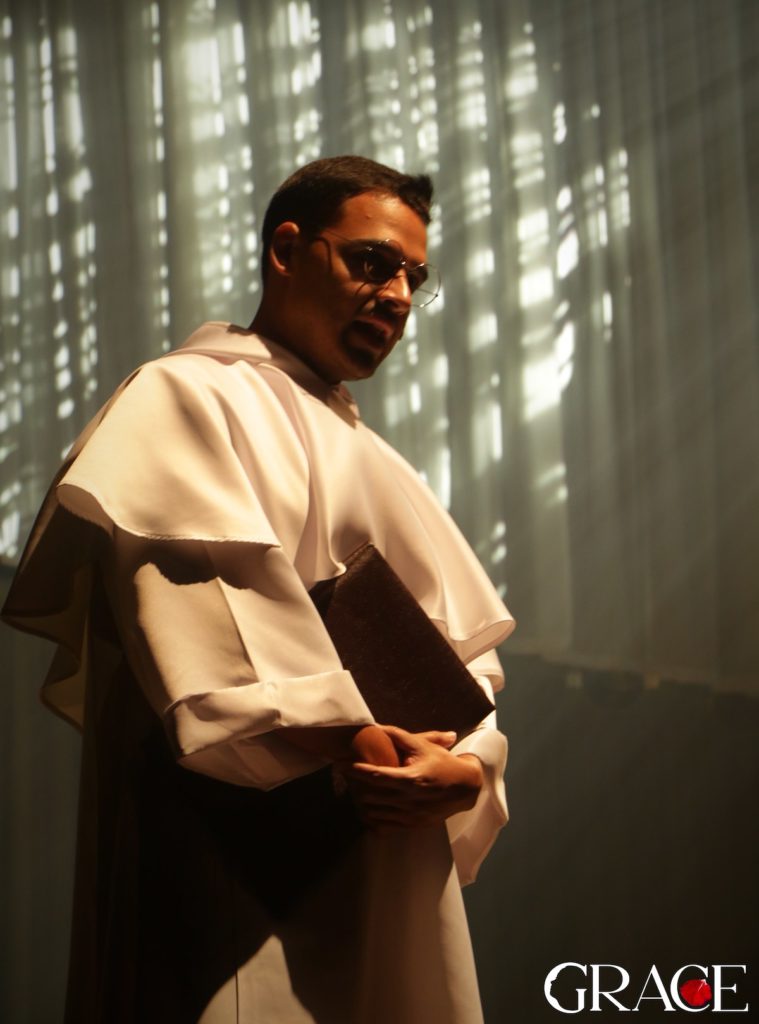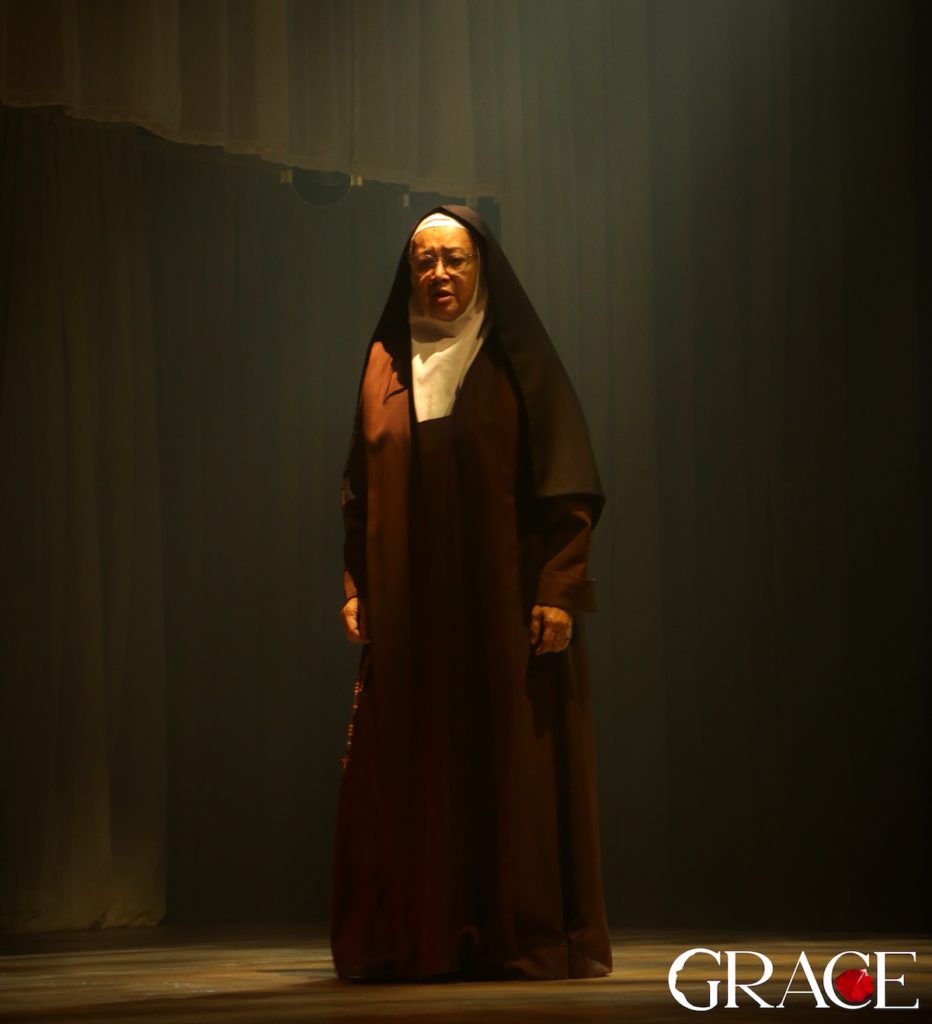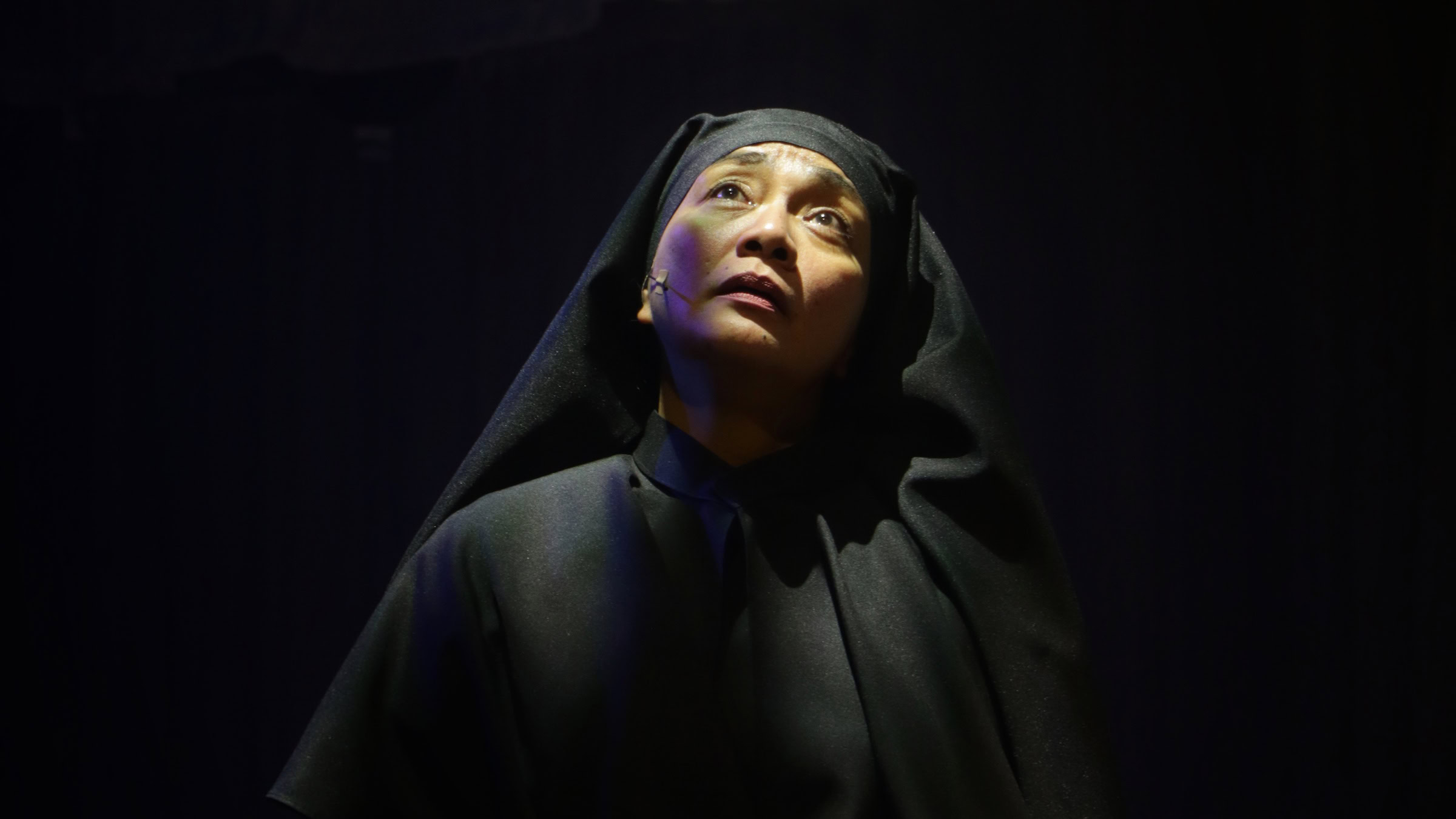It is easy to dismiss that which we do not understand as fantasy. As a person who does not believe in Roman Catholicism, it’s very difficult to understand the power of faith, and even more difficult to understand just how far people are willing to go to protect that belief. An unlikely and tragic story, Floy Quintos’ Grace, currently playing at the Mac Spotlight Theater, may very well be the closest you can come to knowing the answer.
As a child growing up, I was vaguely aware of the story concerning the Miracle at Lipa through the devotion of my grandfather, who had in his collection of relics, two rose petals in between sheets of clear acrylic that came from the supposed rose petal showers. That story, along with the other supernatural reports of dancing suns and mass healing, made it easy to dismiss as one of the many sensational events that gripped the nation leading up to the 1990’s.
what unfolds is a very poignant study of human behavior that is nothing short of shakespearean in magnitude and scale.

In what became Floy Quintos’ final masterpiece, Grace explores this theme of faith. Directed by Dexter M. Santos, the play attempts to dissect the complicated saga surrounding The Miracle at Lipa, Batangas, also known as the Marian Apparitions of Lipa. In 1948. A vision of the Virgin Mary; titled Our Lady Mediatrix of All Grace, allegedly revealed itself to a young postulant in the Discalced Carmelite Monastery, Sister Teresita Castillo. The apparition demanded proof of the virtue, devotion, and humility of Sister Teresita, accompanied by strange phenomenon, namely the showers of rose petals bearing the images of the Blessed Mother, Saint Joseph, and even Christ Himself. It follows the extraordinary story of the visions, and the subsequent response of the Roman Catholic Church amidst the sudden surge of conversions never before seen.
The story of the Miracle at Lipa deals with two different and distinct arcs, the first is the story of the postulant, Sister Teresita, and the visions themselves, and the second is the response of those around her. The play is presented in a hybrid format, with characters frequently speaking to the audience almost as much as they interact with each other, creating a sense that the audience is listening to eyewitness accounts. The set design appears very simple at first, with a simple apron draped with white curtains, but as the show progresses it comes alive with projections that provide supporting information such as character names, dates, location, and other imagery that effectively serves to ground the play.
Grace, in the way it is written, directed, and presented feels finished and polished, which is something that is increasingly rare in today’s theater landscape.
On its face, one may be tempted to expect a straightforward religious discussion, after all: it is public knowledge that the Miracle at Lipa is not recognized by the Vatican as a supernatural event, much less a full-blown miracle, and like my younger self, I would imagine that it is very tempting to dismiss it as hysteria. But instead, what unfolds is a very poignant study of human behavior that is nothing short of shakespearean in magnitude and scale. The audience is treated to a clear-headed exploration of what could have happened in the pursuit of the truth behind the disputed events behind the thick walls of the Carmelite Monastery where the event supposedly occurred, the Residence of the Papal Representative where private conversations first sparked the incredulity of the greater Catholic heirarchy, the examination rooms of the University of Santo Tomas where the candid testimony of both church and lay persons were gathered, and the Council that ultimately sealed the fate of the people involved in the events surrounding the apparition — All places closed to us, and for good reason, but the curtain is parted slightly, which allows us a glimpse of what’s inside.
Faith is a tricky thing, and while plenty of people would argue that faith is eternal and is untouched by the vulgarity of time, it is bound by it. It is fascinating to see a very different Roman Catholic Church from what we see today. Through painstaking research and an astonishing adherence to authenticity in the manner and attitudes held by church leaders during that time, it was very easy to find yourself drawn into the drama unfolding onstage. It is, at times, too real: the biases, the paternalistic tone, and overt sexist and racist positions of the Catholic Church are very hard to see and hear for the more woke faithful of today. But in reality, is it really that different? A common defense is that times have changed, but in many ways it hasn’t. The Catholic Church as an institution still enjoys a reputation of hypocrisy, of unspeakable inertia, a rejection of change, and incredible cruelty against women, the LGBTQIA+, and other marginalized groups that it heartily deserves. It is not for the faint of heart and faith.
The play shines in the way it presents the very human hands that shape the divine to suit their purposes. From the small, humble garden of the Carmelite Monastery in Batangas to the glittering steps of St. Peter’s Basilica itself we are taken through the gauntlet of investigation, of doctrine, of politics, all in the name of ascertaining the truth. The ensemble cast composed of seasoned thespians bring these characters to life, led by Stella Cañete-Mendoza, Shamaine Centenera-Buencamino, Frances Makil-Ignacio, Missy Maramara, Matel Patayon, Leo Rialp, Dennis Marasigan, Nelsito Gomez, Jojo Cayabyab, and Raphne Catorce disappear into their characters seamlessly and completely, pushing the plot forward as a whole.

Grace, in the way it is written, directed, and presented feels finished and polished, which is something that is increasingly rare in today’s theater landscape. Of particular note is the brilliant use of silence as a thematic, as well as a theatrical, device: The isolation felt by each character from the world is palpable in varying degrees, from Sister Teresita’s and Mother Cecilia’s (Cañete – Mendoza, and Centenera – Buencamino, respectively) isolation from the rest of the world in keeping with their order’s rules, the isolation of Fr. De Blas (Gomez) as a singular man of science shouting in the wilderness, to the single-mindedness of Monsignor Vagnozzi (Rialp) — in his somewhat problematic self-assuredness that he speaks with the voice of St. Peter. What we are ultimately presented with is a well-researched, well-fleshed out narrative that asks really big questions about the breadth and depth of our most closely held beliefs. It is truly singular, and its brilliance stands heads and shoulders above the noise of all other productions this season, and deserves the first standing ovation of the year from yours truly.
Click here for more stories like “Grace”. You may also follow and subscribe to our social media accounts: Facebook, YouTube, Instagram, TikTok, Twitter, and Kumu.






















